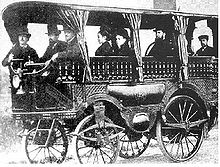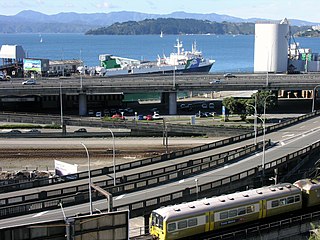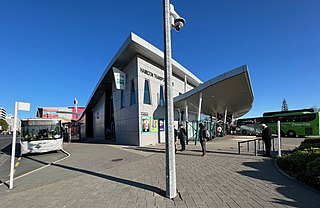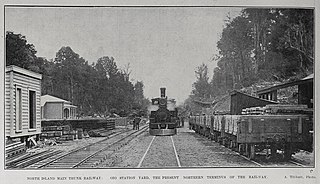
A steam bus is a bus powered by a steam engine. Early steam-powered vehicles designed for carrying passengers were more usually known as steam carriages, although this term was sometimes used to describe other early experimental vehicles too.

A steam bus is a bus powered by a steam engine. Early steam-powered vehicles designed for carrying passengers were more usually known as steam carriages, although this term was sometimes used to describe other early experimental vehicles too.


Regular intercity bus services by steam-powered buses were pioneered in England in the 1830s by associates of Sir Goldsworthy Gurney and by Walter Hancock among others, running reliable services over road conditions which were too hazardous for horse-drawn transportation. Steam carriages were much less likely to overturn, and did not "run away with" the customer as horses sometimes did. They travelled faster than horse-drawn carriages (24 mph or 39 km/h over four miles or 6.4 kilometres and an average of 12 mph or 19 km/h over longer distances). They could run at a half to a third of the cost of horse-drawn carriages. Their brakes did not lock and drag like horse-drawn transport (a phenomenon that increased damage to roads). According to engineers, steam carriages caused one-third the damage to the road surface as that caused by the action of horses' feet. Indeed, the wide tires of the steam carriages (designed for better traction) caused virtually no damage to the streets, whereas the narrow wheels of the horse drawn carriages (designed to reduce the effort required of horses) tended to cause rutting. [2]
However, the heavy road tolls imposed by the Turnpike Acts discouraged steam road vehicles and left the way clear for the horse bus companies, [3] and from 1861 onwards, harsh legislation virtually eliminated mechanically propelled vehicles altogether from the roads of Great Britain for 30 years, the Locomotive Act 1861 imposing restrictive speed limits on "road locomotives" of 5 mph (8.0 km/h) in towns and cities, and 10 mph (16 km/h) in the country. [4]
The Locomotives Act 1865(the famous Red Flag Act) further reduced the speed limits to 4 mph (6.4 km/h) in the country and just 2 mph (3.2 km/h) in towns and cities, additionally requiring a man bearing a red flag to precede every vehicle. At the same time, the act gave local authorities the power to specify the hours during which any such vehicle might use the roads. The sole exceptions were street trams which from 1879 onwards were authorised under licence from the Board of Trade.
In 1881, the engineer John Inshaw built a steam carriage for use in Aston, Birmingham, UK. Capable of carrying ten people at speeds of up to 12 mph, Inshaw discontinued his experiments due to the legislation then in force. [5]

The Red Flag Act was repealed in 1896, and experimental steam buses again operated in various places in England and around the empire.
Liquid Fuel Engineering Co. (Lifu) of Cowes built steam buses from 1897 to 1901. [6] Lifu buses ran at Mansfield from 1 July 1898, [7] between Dover and Deal in 1899, [8] Fairford and Cirencester for the Midland and South Western Junction Railway in 1898 and 1899. [9]
In 1899 a 24 seat (14 on top) bus of E. Gillett & Co (Hounslow) was licensed, but ran no regular service. [7]
Straker buses were run by Potteries Electric Traction from 1901. [8]
London Road car Co ran a Hammersmith-Shepherd's Bush-Oxford Circus route with a Thornycroft 36 seater (12 inside) in 1902. [8]

Thomas Clarkson produced steam buses at Moulsham Works, Chelmsford and exhibited at 1903 and 1905 Motor Shows. [10]
Torquay had steam buses from 1903 to 1923. In May 1903 a Chelmsford steam bus demonstration resulted in the formation of the Torquay & District Motor Omnibus Co Ltd on 23 July 1903. The company's prospectus said, "The Chelmsford motor omnibuses are steam propelled, and, what is of importance in a town of the character of Torquay, are entirely free from smell, noise, and vibration." [11] 3 single deck 14 seat (12 inside and 2 with the driver) Chelmsford steam buses were ordered in May, built in August, but got stuck in mud between Salisbury and Exeter and didn't start a Strand to Chelston service until 2 November. [12] There were 2,828 passengers in the first week. 2 more steam buses arrived in January 1904 and 8 were working by Easter 1905, the last 3 being 20 seaters. They had two-cylinder horizontal engines, with tubular boilers, and a working pressure of 150 to 250psi. They averaged a gallon of paraffin for 3.8 miles. 1904 costs were under 8½d per mile, made up of lubricants 0.2d., wages and fuel 5d. and repairs, establishment, and other charges 3.3d. Fares were 1d. to 4d., with 15 minute frequencies on two routes, and half-hourly on the others. The company declared a 7½% dividend in its first year. [11] All the Torquay buses were sold to Harrogate Road car company just before Torquay Tramways opened in April 1907, but the Torquay Road car Co took over the garage and bought 6 Chelmsfords, 3 from Vale of Llangollen , 2 from Eastbourne Corporation and 1 from Great Western Railway. [12] The new company was liquidated on 24 December 1908 and 3 buses sold to Bargoed Motor Service Company in 1909. The Torquay-Chelston Steam Car Company Ltd was formed on 28 March 1911 and took over the 3 unsold Chelmsfords and a new 25 seater Clarkson type IV steam bus from August 1911. The steam buses were replaced by petrol in 1923, when Devon General started to compete on the Chelston route. [12]

In London Chelmsfords had mixed fortunes. Single-deck Chelmsfords were used by London General Omnibus Co and London Road-Car Co, but the last were withdrawn in 1905 [13] because of heavy losses. [8] However, double deck Chelmsfords with improved boilers were delivered to London Road-Car in 1905 [14] and in 1909 National Steam Car Co. Ltd also started to run double deck Chelmsfords in London. [15] By 1914 National Steam had 184, [16] but post war replacements were petrol and its last steam bus ran in London on 18 November 1919. [17]

Chelmsford buses reached many other places too, but weren't successful. Crewe to Nantwich had double deckers in 1905. London and South Western Railway ran them between Lyndhurst and Milford and Ambleside had 2. [18] India was another destination. [19] Four (or 6) [20] Chelmsford chassis were imported by the New South Wales Railways [21] in 1905. The bodies were constructed in Sydney and the vehicles placed in service on the streets of that city. [22] Even further from their Chelmsford factory, two were imported for a Devonport-Takapuna service in 1904, [23] but were unsuccessful and transferred to Hamilton in 1906. [24] They probably failed to be profitable there too, as horses were again the motive power by 1910. [25] Darracq-Serpollet steam buses were run by the Metropolitan Steam Omnibus Co Ltd from 5 October 1907 to 16 October 1912. When London General took over its main rivals on 1 July 1908 it had 1066 motor buses, 35 of them steam. [26] A year later London General had abandoned steam. [8]
Steam power for road transportation saw a modest revival in the 1920s. It was economical to use, with prices of fuel oil (such as kerosene) being about one-third that of gasoline, with comparable fuel consumption to contemporary gasoline-engined vehicles. [27] Additionally, startup times vis-a-vis gasoline-powered vehicles and safety issues from vaporized fuel had been solved, with steam cars such as the Doble requiring a mere 40 seconds to start from cold. In 1931 Doble was employed as a consultant by A & G Price of Thames, New Zealand to construct a steam engine for buses. Four were built in 1931, [28] but plans were shelved as the depression deepened and the Auckland bus was too heavy for the roads. [29] However, two 1932 reports described progress with construction. [30] [31]

The Canadian company Brooks Steam Motors of Toronto, Ontario produced steam city buses in the 1920s. More recently, in 1972, the American inventor Bill Lear introduced a steam bus intended for trials in San Francisco. [32]
A steam bus named Elizabeth operates in Weston Super Mare (originally in the English seaside town of Whitby).

Transport in New Zealand, with its mountainous topography and a relatively small population mostly located near its long coastline, has always faced many challenges. Before Europeans arrived, Māori either walked or used watercraft on rivers or along the coasts. Later on, European shipping and railways revolutionised the way of transporting goods and people, before being themselves overtaken by road and air, which are nowadays the dominant forms of transport. However, bulk freight still continues to be transported by coastal shipping and by rail transport, and there are attempts to (re)introduce public transport as a major transport mode in the larger population centres.

The North Island Main Trunk (NIMT) is the main railway line in the North Island of New Zealand, connecting the capital city Wellington with the country's largest city, Auckland. The line is 682 kilometres (424 mi) long, built to the New Zealand rail gauge of 1,067 mm and serves the large cities of Palmerston North and Hamilton.

Ellerslie railway station serves the Southern and Onehunga Lines of the Auckland railway network in New Zealand. It was opened in 1873. It has an island platform and is 1.37 km (0.85 mi) south of Greenlane and 1.45 km (0.90 mi) north of Penrose.
The New Zealand Railways Department, NZR or NZGR and often known as the "Railways", was a government department charged with owning and maintaining New Zealand's railway infrastructure and operating the railway system. The Department was created in 1880 and was corporatised on 1 April 1982 into the New Zealand Railways Corporation. Originally, railway construction and operation took place under the auspices of the former provincial governments and some private railways, before all of the provincial operations came under the central Public Works Department. The role of operating the rail network was subsequently separated from that of the network's construction. From 1895 to 1993 there was a responsible Minister, the Minister of Railways. He was often also the Minister of Public Works.

Papakura railway station is a railway station in Papakura, New Zealand, on the Southern Line of the Auckland railway network.

Trams in New Zealand were a major form of transport from the 19th century into the mid-20th century. New Zealand's first (horse) tramway was established in 1862 (Nelson), followed by a steam tramway in 1871 (Thames), and the first electric tramway in 1900. In New Zealand railway terminology a bush tramway is an industrial tramway, which usually did not carry passengers.

Devon General was the principal bus operator in south Devon from 1919. The name was first used by the Devon General Omnibus and Touring Company which was created in 1919. In 1922 it was purchased by the National Electric Construction Company which merged with British Electric Traction in 1931. Nationalisation in 1969 resulted in 1971 with the company being merged into Western National. In 1983 a new Devon General Limited was created which became the first operating subsidiary of the National Bus Company to be privatised in 1986 when it became the first company of Transit Holdings. It was sold to the Stagecoach Group in 1996 and renamed Stagecoach Devon in 2003.

Ōhaupō railway station was a station located at Ōhaupō on the North Island Main Trunk in New Zealand. It was the terminus of the line from Auckland from 1878 to 1880 and closed in 1982. Only a passing loop remains.

Mercer railway station in Mercer, New Zealand, is 72 km from Auckland and 609 km from Wellington on the North Island Main Trunk line. It opened on 20 May 1875 and was closed to passengers about 1970 and to goods in the 1990s. It burnt down in 1879 and also in 1900. Until 1958 it was the first refreshment stop south of Auckland.

Go Bus Transport Ltd is a large bus company in New Zealand owned by Australian-based transport operator Kinetic Group. The company is based in Hamilton, New Zealand, and runs bus services in Hamilton, Hawke's Bay, Tauranga, Christchurch, Gisborne, Dunedin and Invercargill.
State Highway 23 (SH 23) is a New Zealand state highway that connects the towns of Raglan and Hamilton.

Te Uku is a small, mainly farming, settlement on SH23 in the North Island of New Zealand, located 34 km (21 mi) from Hamilton and 11 km (6.8 mi) from Raglan. It has a 4-Square shop, church, coffee stall and art gallery, filling station, hall, school and Xtreme Zero Waste recycle bins.

Public transport in Hamilton and the Waikato Region is poorly developed. Only 0.9% of trips were made by bus in 2013/14. This compares with 2.3% nationally, which itself is amongst the lowest modal shares in the world. A Mass Transit Plan aiming to increase public transport's share in Hamilton from 3 to 10% by running services at 10 minute intervals, was to be developed in 2019, but has yet to be funded by NZTA. Waikato, like all other regions, with the exception of Auckland and Wellington, saw falls in use of public transport from 2012. As the map shows, the coverage is sparse and, even of those services which operate daily, most have only 2 or 3 buses a day in each direction. Only Hamilton urban services and those to Huntly run hourly, or more frequently. About 40% of passengers travel on the two routes which run at 15 minute intervals. From Monday 21 February 2022 the less frequent Hamilton buses were cut to hourly, or 2-hourly, due to driver shortages.

The Northern Steam Ship Company Ltd (NSS) served the northern half of the North Island of New Zealand from 1881 to 1974. Its headquarters, the Northern Steam Ship Company Building, remains in use on Quay St, Auckland as a bar.

Marton railway station was a station and rail junction on the Marton–New Plymouth Line, opened on 4 February 1878. After the North Island Main Trunk (NIMT) made a junction to the south of Marton, a new station was built there and the old station renamed and downgraded, in 1898.

Ohinewai Railway Station was a flag station on the North Island Main Trunk line, serving Ohinewai in the Waikato District of New Zealand, 59 mi (95 km) south of Auckland. It was 8.18 km (5.08 mi) north of Huntly, 7.26 km (4.51 mi) south of Rangiriri and 33 ft (10 m) above sea level. It was in the village, just north of Tahuna Rd.

Kakahi was a station on the North Island Main Trunk line, in the Ruapehu District of New Zealand, serving Kakahi. It formally opened on 9 November 1908. The rails were laid south of Piriaka by May 1904 and a daily ballast train was running by October, which also carried passengers. Kakahi Bridge has five spans of 44 ft (13 m) and one of 23 ft (7.0 m) supplied by G. Fraser & Sons of Auckland, which delayed construction to the south. It crosses the Kakahi Stream, which was sometimes called the Waitea River.
SS Tauranga was the first coastal trading steam ship to be built in New Zealand, though a harbour steamer, Governor Wynyard, had been built at Auckland in 1851.

Oio was a station on the North Island Main Trunk line, in the Ruapehu District of New Zealand. It served the hamlet of Oio, which lay to the north of the station. It was 8.29 km (5.15 mi) north of Raurimu and 5.64 km (3.50 mi) south of Ōwhango. It was one of the many temporary railheads along the route, with work going on from 1904 to 1908.

Horopito was a station on the North Island Main Trunk line, in the Ruapehu District of New Zealand. It served the small village of Horopito and lies just to the north of two of the five largest NIMT viaducts. It and Pokaka also lay to the south of Makatote Viaduct, the late completion of which held up opening of the station.